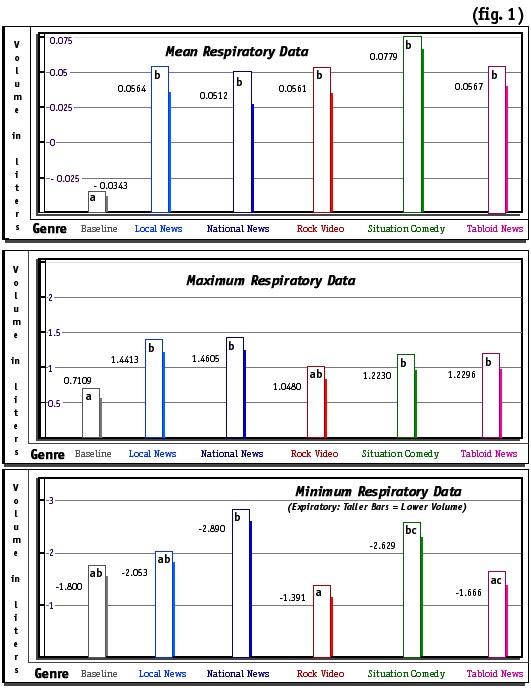Media Effects Research Lab - Research Archive
Respiratory responses to television genres
Student Researcher(s)
Carson B. Wagner (Masters Candidate);
Faculty Supervisor
FOR A COMPLETE REPORT OF THIS RESEARCH, SEE:
Wagner, C. B., & Sundar, S. S. (1998, November). Respiratory responses to television genres. Paper presented to the Intrapersonal Communication and Social Cognition Division at the 84th annual convention of the National Communication Association (NCA), New York City.
INTRODUCTION
Different genres of television programs induce different emotions. Each emotion, in turn, has its own characteristic breathing pattern. We laugh at comedic programs, and we sob during those rife with melancholy. We find ourselves breathing hard and heavy during suspenseful shows, and gasping when they horrify us. But, do those moments of suspense and outbreaks of laughter, along with the general moods created by the shows, affect our overall breathing patterns as we watch? Prior research has shown that correlations exist between television programming and emotion, and between emotion and respiratory patterns. However it is not clear whether the effects of television programs are strong enough to elicit specific respiratory reactions. This exploratory study was designed to investigate whether different television program genres elicit distinct respiratory patterns.
METHOD
Twenty one participants took part in a within-participants experiment. Respiratory volume was recorded while participants viewed five segments of television programming: Situation Comedy, Local News, National News, Rock Video, and Tabloid News.

The volume data were used to arrive at three dependent measures: minimum volume of respiration, maximum volume of respiration, and mean volume of respiration.
RESULTS
Overall, the findings show that television programming genres elicit distinguishable respiratory patterns. The results for Mean Respiratory Volume show that a significant difference exists between baseline and each of the genres. The minimum and maximum respiratory volume data show that each program genre has a distinct respiratory pattern (see fig. 1).

CONCLUSIONS
Overall, the findings show that television program genres elicit distinguishable respiratory patterns. Comparative data amongst genres indicate that no two genres share the same inspiration and expiration relationship with each other. This study, for the first time, demonstrates psychophysiological correlates for television genres. It is likely that these correlates are specific to states of emotion. It is probable that distinct categories of other TV program genres will cause similarly generalizable reactions. The results from this exploratory study suggest that further investigation linking emotion and media consumption through respiratory patterns can yield a better understanding of how various media genres affect viewers.
For more details regarding the study contact
Dr. S. Shyam Sundar by e-mail at sss12@psu.edu or by telephone at (814) 865-2173

